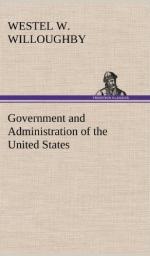Geological Survey.—This branch of the Interior Department was established in 1879. Its work is the investigation and determination of the geological structure of the various sections of the country, the composition of soils, the reclamation of waste lands, etc. In this bureau are made topographical surveys and irrigation surveys of arid regions of the United States. The publications connected with this work, number ten Annual Reports, thirteen Monographs, fifty-eight Bulletins and five Statistical Papers. In these there is a discussion of the geological structure of every state and territory, and information concerning the occurrence and production of each great metallic and mineral staple of the country. The bureau comprises one geographical, twelve geological, six paleontological and four accessory divisions. A division of mines and mining publishes an annual report on the mineral resources and production of the United States.
The Superintendent of the Census.—The Superintendent of the Census is appointed each decade for the purpose of taking the regular decennial census. The Eleventh Census has just been taken. The first was taken in 1790. Each census has shown a tendency to be more elaborate and to embrace a greater number of subjects than any preceding. There were employed in the taking of the Eleventh Census 42,000 enumerators, 2,000 clerks, from 800 to 900 special agents, 175 supervisors and 25 experts.
In addition to these eight bureaus, the department has charge of various other branches of government. All of the territories come under the Secretary’s supervision, and look to him in case of any difficulty. The Secretary also has charge of the Yellowstone National Park, the Hot Springs Reservation in Arkansas, and of certain hospitals and eleemosynary institutions in the District of Columbia. A Superintendent of Public Documents looks after the receipt, distribution, and sale of government publications.
The most important subjects of recent legislation concerning this department have been the dependent pension act, the act providing for the survey of Western lands suitable for irrigation, and the land forfeiture act. By this act over 8,000,000 acres of lands were forfeited by the railroads for failure to fulfill the conditions under which the land was originally granted to them.
_#The Post Office Department.#_—The Post Office Department was established in 1789, but the Postmaster-General did not become a cabinet officer until 1829. The Postmaster-General has charge and management of the department, and of the domestic and foreign mail service. He can establish post offices and appoint postmasters of the fourth and fifth classes, i.e. those whose salaries are less than $1,000. These number over 50,000. The total number of postoffices is about 56,000. The President appoints to those of the first three classes. Other officers besides the Assistant Postmasters-General are, the Superintendents of the Money Order Division, of Foreign Mails, and of the Railway Service, and an Assistant Attorney-General for the department.




